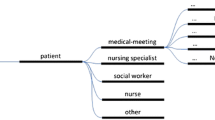Abstract
Ambulatory Care facilities (often referred to as diagnosis and treatment centres) separate the routine elective activity from the uncertainty of complex inpatient and emergency treatment. Only routine patients with predictable outcomes should be treated in Ambulatory Care. Hence the centre should be able to plan its activities effectively. This paper considers the consequences for the remaining elective inpatient bed and theatre requirements. Computer models are used to simulate many years of activity in an orthopaedic department at a typical District General hospital.
The adoption of Ambulatory Care will increase the proportion of day case treatment but the reduction in the overall bed requirement will be relatively small (at most 10%). Separating the elective theatre activity into day case and inpatient sessions will tend to produce inpatient theatre sessions with a disproportionate number of longer procedures. This can reduce overall theatre utilisation by up to 15%, which implies the need for an increase of up to 18% in the number of theatre sessions if waiting times are to be maintained.
Similar content being viewed by others
References
Audit Commission, Day Surgery Report (Audit Commission, London, 2001).
A. Bagust, M. Place and J.W. Posnett, Dynamics of bed use in accommodating emergency admissions: Stochastic simulation model, British Medical Journal 319 (1999) 155–158.
P. Baskerville, All in a days work, BMA News Review (August 2000) 22–23.
J. Bowers and G. Mould, On defining Ambulatory care in practice, British Journal of Health Care Management 8 (2002) 305–309.
J. Bowers and G. Mould, Organisational implications of concentration of emergency orthopaedic services, Health Bulletin 59 (2001) 381–387.
P. Butler, Praise for health production-line, The Guardian (9 November 2000).
A.R. Claxton, S.A. Lindsay, J.C. Watts and I. Smith, Ambulatory anaesthesia practices in the United Kingdom, Seminars in Anaesthesia 16 (1997) 178–188.
C. De Lathouwer and J.P. Poullier, How much ambulatory surgery in the world 1996–1997 and trends? Ambulatory Surgery 8 (2000) 191–210.
Department of Health, The NHS Plan, A plan for investment, A plan to reform (2000). Available from: URL: http://www.nhs.uk/nationalplan.
Department of Health (England), Hospital Episode statistics (2000/1). Available from: http://www.doh.gov.uk/public/stats1.htm.
Information Services Division, Common Services Agency for the NHS in Scotland, Scottish Health Statistics (ISD, Edinburgh, 2000).
J.B. Jun, S.H. Jacobson and J.R. Swisher, Application of discrete-event simulation in health care clinics: A survey, Journal of the Operational Research Society 50 (1999) 109–123.
K. Newman, Towards a new health care paradigm: Patient-focused care, the case of Kingston Hospital Trust, Journal of Management in Medicine 11 (1997) 357–371.
J. Nicholson, Patient focused care and its role in hospital process re-engineering, International Journal of Health Care Quality Assurance 8 (1995) 23–26.
J.D. Papstravou, S. Rajagopalan and A.J. Kleywegt, The dynamic and stochastic knapsack problem with deadlines, Management Science 42 (1996) 1706–1718.
Simul8, Visual Thinking, Glasgow.
Author information
Authors and Affiliations
Corresponding author
Rights and permissions
About this article
Cite this article
Bowers, J., Mould, G. Ambulatory Care and Orthopaedic Capacity Planning. Health Care Manage Sci 8, 41–47 (2005). https://doi.org/10.1007/s10729-005-5215-4
Received:
Accepted:
Issue Date:
DOI: https://doi.org/10.1007/s10729-005-5215-4




